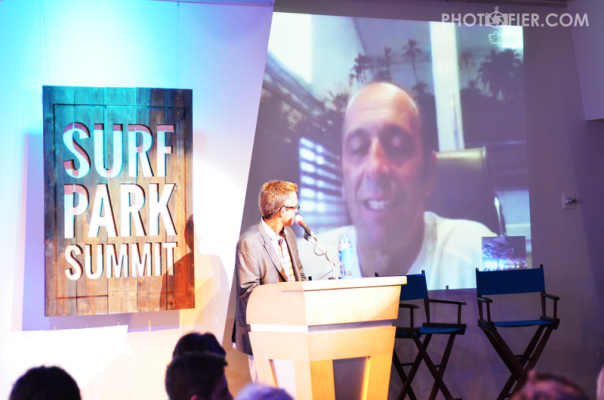
PT Townend works the crowd again. Photo: Nick Teague
Since Surf Park Summit took place earlier this month, there’s been a fair amount of media buzz in and around the industry. Most has come in the form of general recaps detailing who spoke about what at the conference and how the day shook out. But there have also been those occasional implicational statements and opinions made about what surf parks will or won’t mean for the future of surfing and the extended community, culture, environment, world, etc. A couple of those have come directly from members of the surfing community who’ve thoughtfully shared their opinions about the impending surf park industry.
I’m going to address a couple of these worthy thoughts here as basis for a more pointed recap of what the Summit was really all about. In response to Christian Beamish’s Surfline article, Surf Park Summit: More Surfers, More Stoke?, a reader dubbed SJ101 commented:
“While I can fully appreciate the commercial rationale for wave pools, I don’t see the cultural aspect going any further than trend of the month/year. There is just no way a kid from Kansas is going to be able to fully appreciate the pure joy of riding natural waves, unless maybe, he has also had an extended experience on the coast. The thing I don’t understand is why we aren’t putting the same kind of energy into man-made reefs. There are thousands of miles of coastline that could be improved.”
To begin breaking down the comment, we’ll start with a quote from Scott Bass’ opening remarks at the Summit:
“The [surf] industry is at the same place now as the skate industry was at the urethane wheel.”

Fernando Aguerre, President of the ISA, joins emcee Scott Bass live from Buenos Aires where he was attending a meeting with the International Olympic Committee. Photo: Ofier Zigner
I’m not here to give a history lesson on the skate industry, nor am I qualified to do so as a cut-rate skater, but given just a small measure of actual research, and memories from both Lords of Dogtown movies, it’s abundantly clear that the invention of the urethane and then polyurethane wheel played a huge role in the advent of vert ramps and full-blown skateparks.
Before the urethane wheel, you had a small population of dedicated skaters, most of whom were surfers looking for a way to “surf outside the ocean,” ironically enough. They began skating for fun in local areas when the swell was down. Then, as skating caught more of the public eye, they occasionally competed in small, comparatively weak events when measured against today’s standards.
Then came the modern wheel, the subsequent explosion of skating that’s led to the X Games, Tony Hawk’s 900, 12-year-old Tom Schaar’s 1080 and beyond. If the history of skating/skateparks can draw any parallel implications for the surf industry/surf parks, and if Scott Bass’ comment is anywhere near accurate, then we are in fact at a serious “tipping point” in the culture/history of surfing as we know it. So how does that tie into SJ101’s comment?
In his opening sentence, SJ remarks that he doesn’t “see the cultural aspect going any further than trend of the month/year.” But if you look at what happened to the skate industry and the huge culture that was created and is sustained today, thanks to skateparks and the skaters/innovators that have made them a reality, you have to wonder if perhaps this viewpoint is a bit narrow in scope. For a whole new generation of surfers, the existence of these parks could quite likely be the culture-shaper of the future of surfing.

